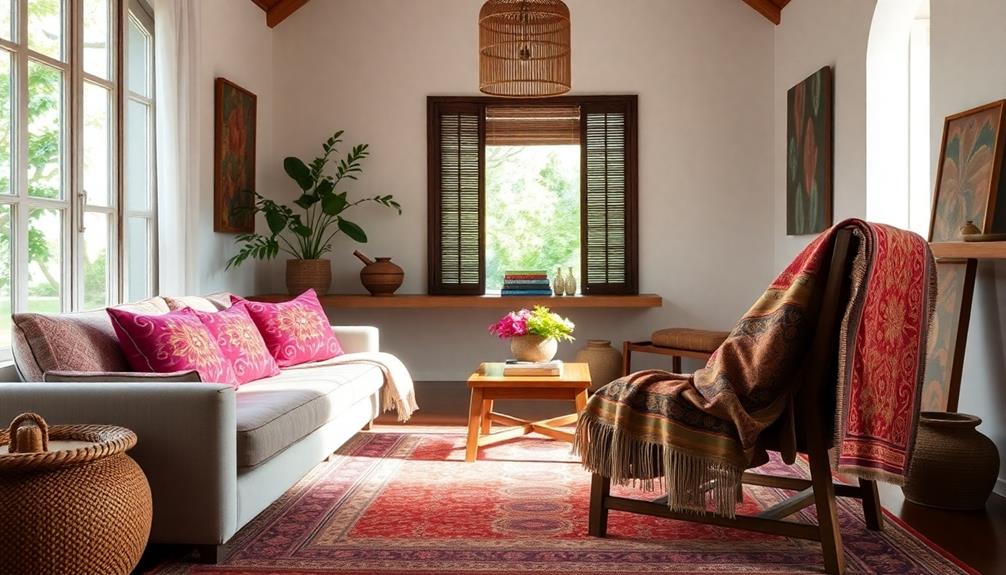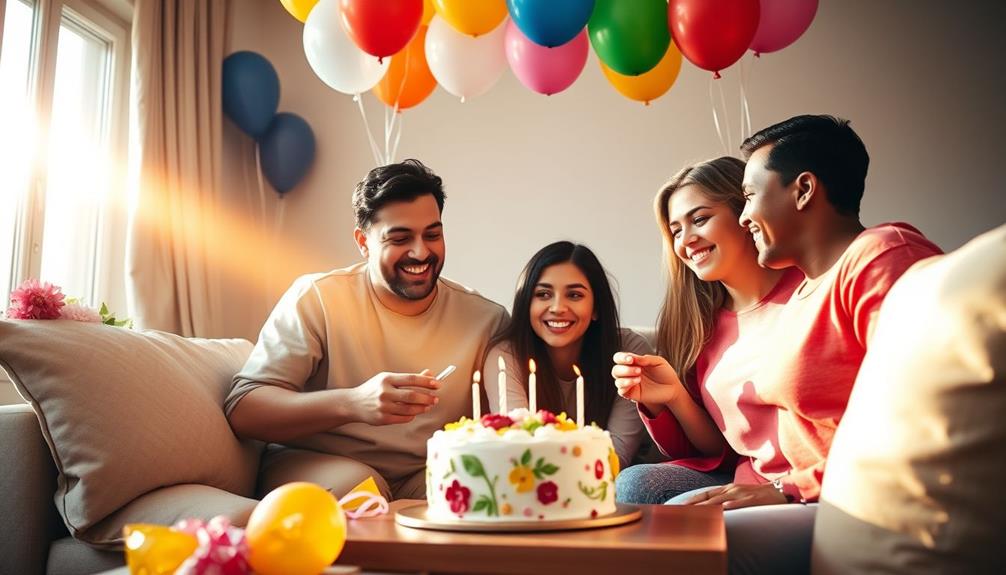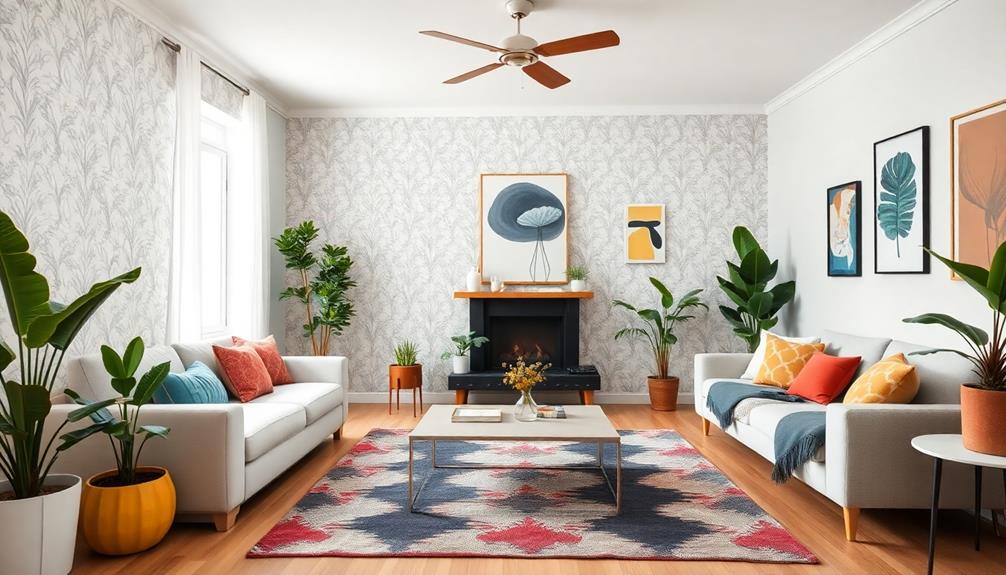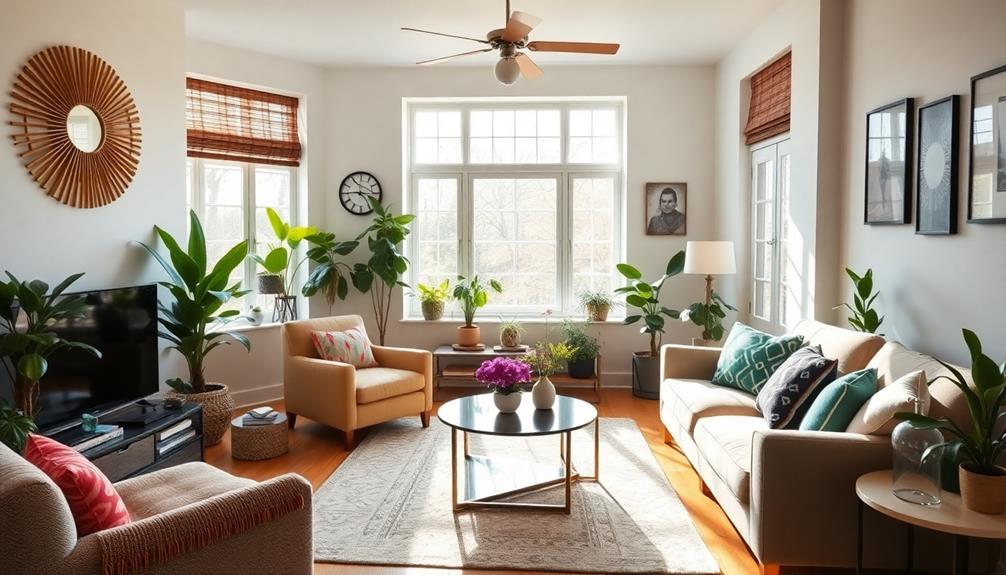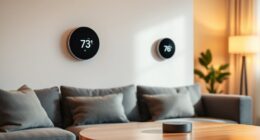Indonesian textiles add effortless elegance to your home by combining intricate artistry with cultural depth. Fabrics like batik and ikat feature stunning patterns and vibrant colors that capture stories from Indonesia's rich heritage. When you use songket as a luxurious throw or tenun as accent pieces, you instantly elevate your space. These textiles not only enhance aesthetics but also promote sustainability and support local artisans. Each piece serves as a unique conversation starter, enriching your home's narrative. Discover how incorporating these beautiful textiles can transform your decor into a stylish oasis that reflects tradition and modern sensibilities.
Key Takeaways
- Indonesian textiles, like batik and ikat, feature intricate patterns that add unique charm and character to any space.
- Handwoven fabrics reflect regional identities, creating a sense of authenticity and cultural connection in your home decor.
- The luxurious appearance of songket and tenun enhances elegance, making them perfect for statement pieces in various settings.
- Sustainable production practices emphasize natural materials and traditional techniques, aligning with eco-conscious values in contemporary design.
- Each textile tells a story, inviting admiration and conversation while celebrating Indonesia's rich heritage and craftsmanship.
The Art of Batik

What makes batik such an enchanting art form? Originating from Java, Indonesia, batik employs a wax-resist dyeing technique that creates intricate patterns, characterized by lines (baris) and dots (titik). This traditional process involves using a tjanting tool or copper stamp (cap) to apply wax before dyeing the fabric, resulting in vibrant designs that captivate the eye.
The artistry of batik is often complemented by traditional Indonesian decor masks, which enhance the aesthetic appeal of home spaces with their unique designs and rich cultural stories. Traditional artistry is evident in both these crafts, showcasing the skill of Indonesian artisans.
Batik isn't just beautiful; it holds deep cultural significance. Each pattern can symbolize social status and regional identity, reflecting the rich heritage of Indonesian communities. In 2009, UNESCO recognized batik as a Masterpiece of Oral and Intangible Heritage, highlighting its importance in global culture.
Today, batik has evolved, finding a place in contemporary fashion while maintaining its roots. You can see it worn at various occasions, bridging the gap between tradition and modernity.
Celebrated on National Batik Day, this art form continues to thrive, promoting both its historical context and its relevance in today's world. As you incorporate batik into your home, you embrace not just an aesthetic choice but a piece of cultural history that speaks volumes about artistry and identity.
The Beauty of Ikat
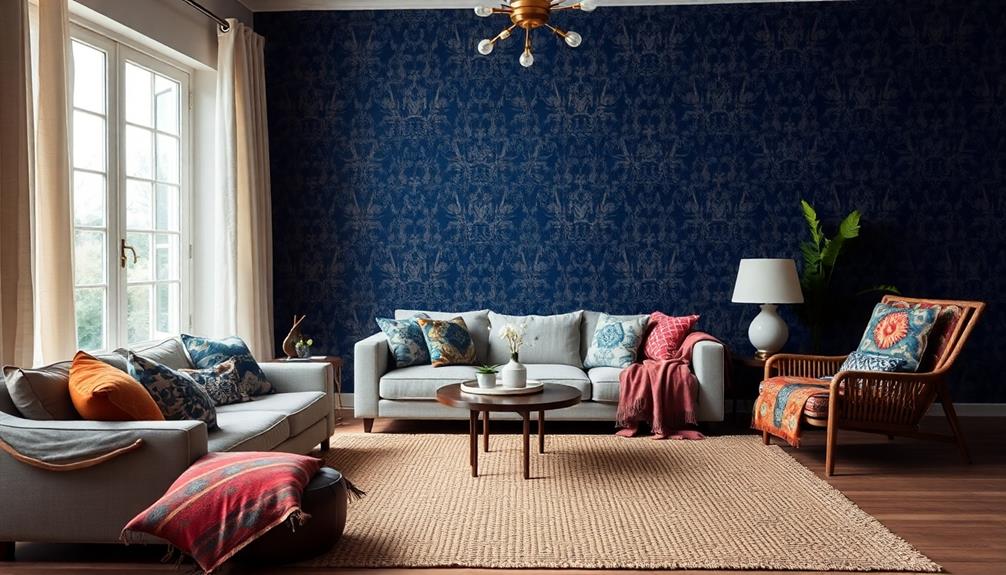
Ikat textiles are a stunning demonstration of Indonesia's rich cultural heritage, showcasing the skill and creativity of local artisans. This traditional form of Indonesian textiles involves a unique binding and dyeing technique that creates complex patterns reflecting cultural stories and ancestral lineage. By using natural dyes, artisans produce vibrant colors that breathe life into each fabric, making them a treasure for any home.
These textiles often share similarities with other traditional Indonesian handicrafts, such as Face Indonesian Decor Mask, which also celebrate the nation's artistic diversity.
Ikat's intricate craftsmanship has gained international recognition, making it a sought-after choice for both fashion and home decor. The final product, woven after the bindings are removed, reveals striking designs often featured in clothing and ceremonial items. Each pattern carries deep cultural significance, symbolizing myths and local traditions that resonate with the wearer or viewer.
Integrating Ikat into your home not only adds elegance but also tells a story, connecting you to the vibrant culture of Indonesia. Whether you opt for a bold throw pillow or a stunning wall hanging, these textiles serve as beautiful, meaningful additions to your space.
Embrace Ikat and let its unique charm elevate your home decor while celebrating the artistry of Indonesian craftsmanship.
Luxurious Songket Textiles

Building on the rich tapestry of Indonesian textiles, luxurious songket fabrics stand out as symbols of prestige and elegance. These exquisite textiles, primarily produced in regions like Sumatra, are woven with gold or silver threads, making them a true reflection of the artistry and craftsmanship of local weavers.
Each songket features intricate patterns that often depict flora and fauna, reflecting deep cultural significance. Additionally, the vibrant colors and unique designs of these textiles can seamlessly complement various interior styles, enhancing the aesthetic appeal of your home. Incorporating Indonesian decorative pillows alongside songket can create a cohesive look that celebrates cultural heritage.
Traditionally worn by royalty and during special occasions, songket textiles aren't just decorative; they carry stories and rituals that express the social status of the wearer. Their use in ceremonial contexts, such as weddings and religious celebrations, highlights their importance in preserving heritage and community identity.
In today's world, songket has evolved, incorporating modern fashion trends while maintaining traditional designs. This versatility allows you to incorporate luxurious songket textiles into your home decor, creating an effortless elegance that resonates with both history and contemporary style.
Cultural Significance of Textiles
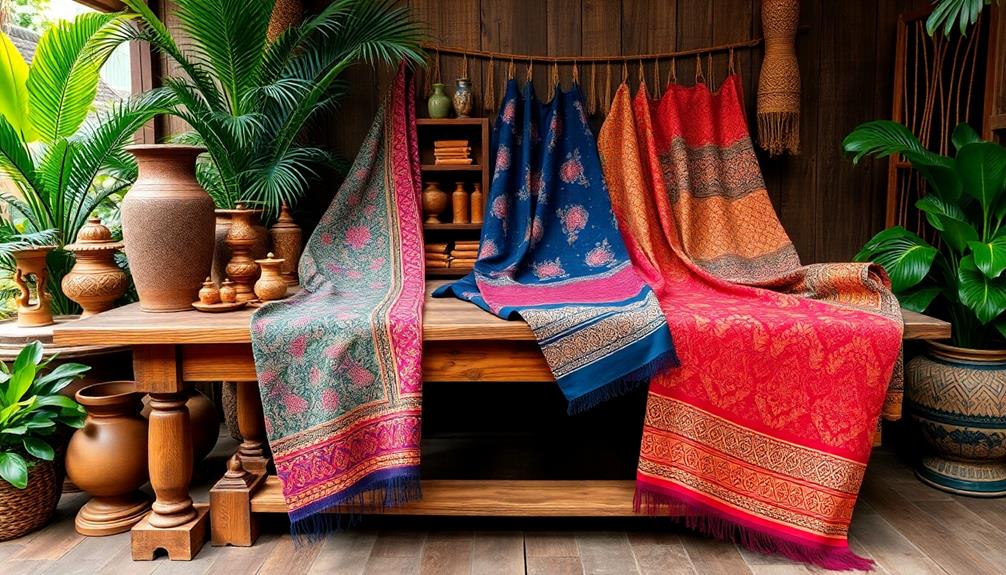
Textiles in Indonesia are more than just fabric; they're vibrant storytellers that weave together the nation's history and cultural identity. Each piece, whether it's batik or songket, carries deep-rooted cultural narratives that reflect the diverse tapestry of Indonesian society.
These textiles aren't just beautiful; they signify important aspects of life and heritage. The artistry involved in creating these textiles often parallels the intricate designs found in Indonesian decor masks, showcasing local myths and folklore.
- Batik showcases intricate designs that vary across regions, revealing local craftsmanship and community identity.
- Songket, often woven with gold or silver threads, is reserved for special occasions, symbolizing luxury and cultural significance in ceremonial practices.
- Unique patterns highlight social status and ancestral lineage, connecting generations through artistry.
- Regional traditions infuse each textile with specific meanings, making them essential to cultural rituals.
- The production and use of these textiles strengthen community relationships, emphasizing their role in maintaining cultural practices.
Modern Adaptations in Design
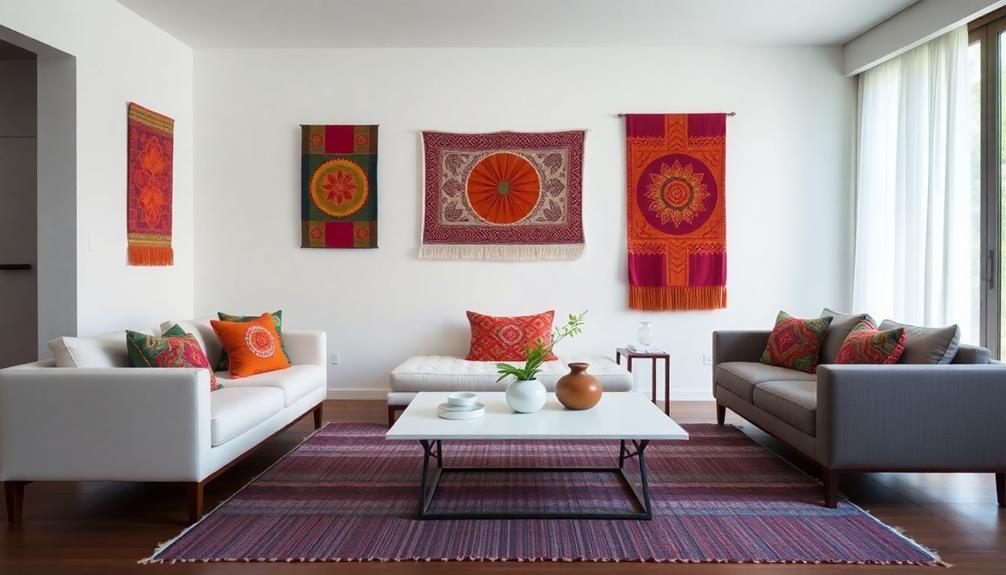
Indonesian textiles have found a vibrant new life in modern design, seamlessly blending tradition with contemporary aesthetics. Designers are increasingly incorporating traditional fabrics like batik, ikat, and songket into home decor, creating unique, stylish living spaces that exude effortless elegance.
These modern adaptations of batik have expanded beyond formal attire to vibrant everyday textiles, making them perfect for various settings. The integration of these textiles in traditional Indonesian style home decor highlights their versatility and ability to enhance the overall ambiance of a space.
The global interest in Indonesian textiles has sparked international collaborations that prioritize innovative designs while maintaining cultural authenticity. As contemporary consumers become more eco-conscious, the appeal of these textiles grows, thanks in part to the use of sustainable options and eco-friendly dyeing techniques.
This shift not only preserves the rich heritage of Indonesian art but also aligns with modern values. Ongoing promotion of Indonesian textiles at fashion shows and exhibitions worldwide has elevated their status, making them a sought-after choice for chic, culturally rich home aesthetics.
Sustainability in Textile Production
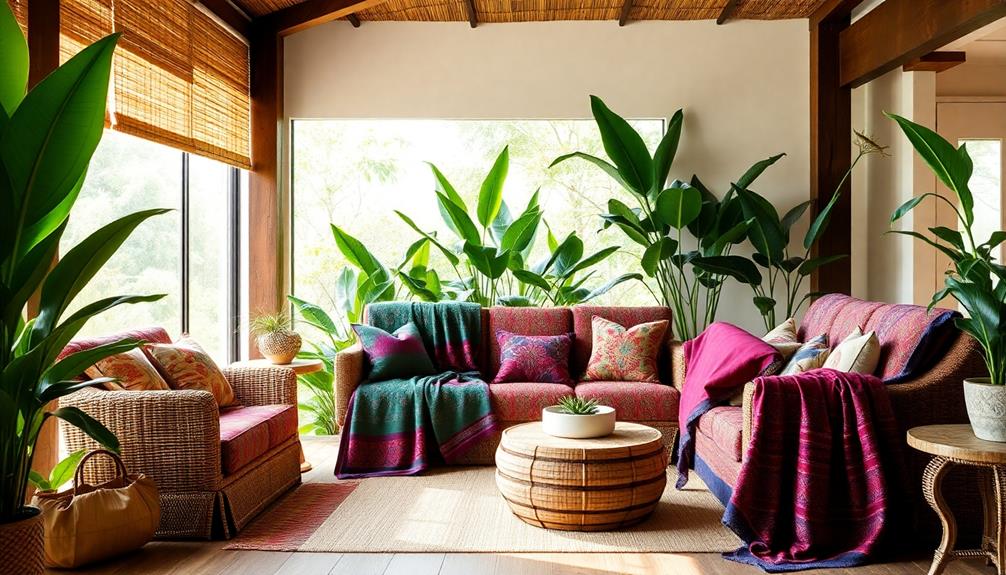
In the domain of textile production, sustainability plays an essential role in preserving both culture and the environment. Indonesian textiles, such as batik, ikat, and songket, exemplify this commitment to sustainable practices. By employing traditional methods, artisans not only create exquisite fabrics but also contribute to ecological balance.
These textiles often incorporate natural motifs and patterns, reflecting the rich cultural heritage of Indonesia and aligning with the principles of Balinese design characteristics.
Here are some key aspects of sustainability in Indonesian textile production:
- Use of natural dyes that minimize environmental impact
- Hand weaving techniques that support local resources and craftsmanship
- Promotion of sustainable livelihoods for communities across the archipelago
- Preservation of biodiversity through responsible harvesting of dye plants
- Revival of cultural heritage that encourages a shift away from synthetic fabrics
Through organizations like Threads of Life, over 1,000 weavers are empowered to maintain their cultural practices while fostering a deep connection with their natural environments.
This not only sustains their communities but also enhances awareness of the significance of traditional textiles in modern fashion. By choosing these exquisite pieces, you embrace a lifestyle that values sustainability, supports local artisans, and honors the rich cultural heritage of Indonesia.
Incorporating Textiles in Decor
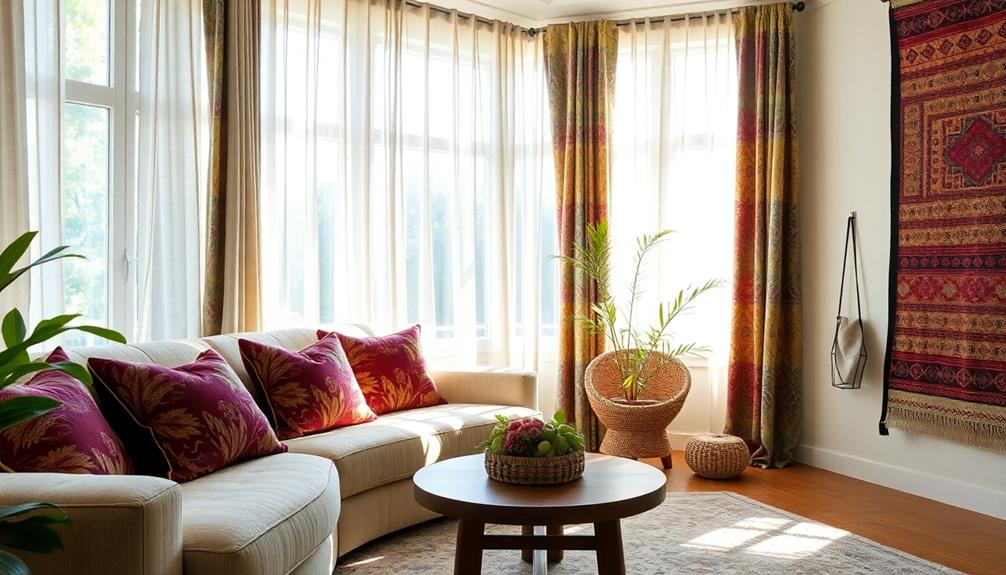
Transform your living space by incorporating the vibrant colors and intricate patterns of Indonesian textiles. These handwoven fabrics, like batik, ikat, and songket, add a unique touch of cultural elegance to your home decor. With distinct motifs reflecting local heritage, each piece tells a story of traditional craftsmanship.
You can elevate your decor by using songket as decorative throws or wall hangings. The luxurious fabric, often featuring gold or silver threads, brings a sense of wealth and status to your space. Ikat-patterned cushions serve as a visual focal point, infusing your room with striking beauty and ancestral significance.
Explore the versatility of Indonesian textiles; they seamlessly blend into various design styles—from traditional warmth to contemporary chic. Here's a quick look at how you can incorporate these textiles:
| Textile Type | Usage |
|---|---|
| Batik | Table runners, curtains |
| Ikat | Cushions, upholstery |
| Songket | Throws, wall hangings |
| Tenun | Accent pieces, wall art |
| All | Mix and match for effortless elegance |
Celebrating Regional Diversity
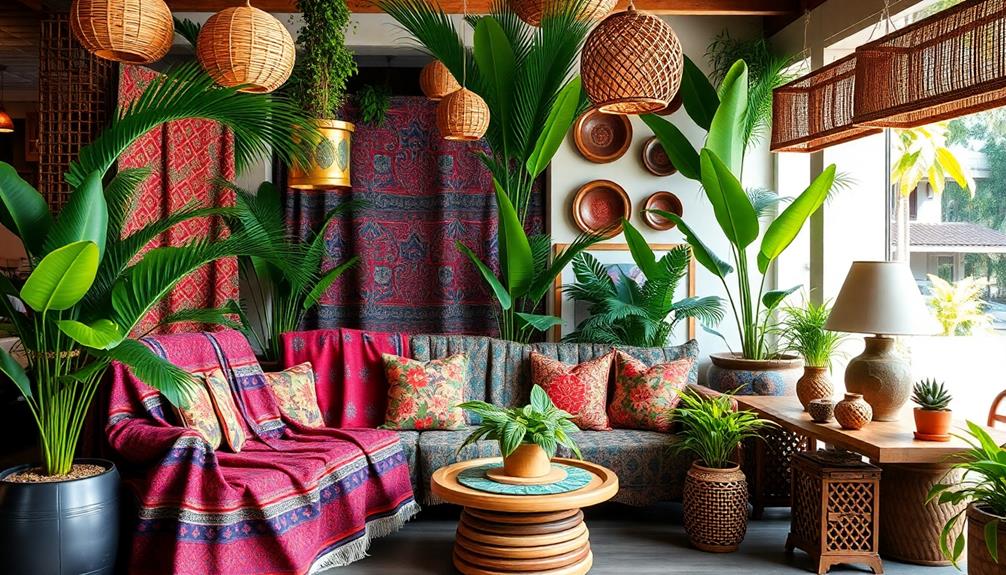
When you explore Indonesian textiles, you'll discover unique regional craftsmanship that tells a story.
Each piece—be it batik, ikat, or songket—carries cultural significance that reflects the identity of its community.
Traditional Indonesian housing, known for its unique architectural styles and construction materials, similarly showcases the rich tapestry of cultural heritage that permeates the nation traditional Indonesian housing.
Celebrating this diversity not only enhances your home decor but also honors the rich heritage of Indonesia.
Unique Regional Craftsmanship
Indonesian textiles epitomize the richness of regional craftsmanship, celebrating the diverse cultural identities woven into each fabric. You'll discover that these textiles aren't just beautiful; they embody unique regional craftsmanship, showcasing the traditional techniques passed down through generations.
Each type tells a story through its intricate designs, often reflecting themes and motifs found in Indonesian wedding decor ideas that enhance the beauty of cultural celebrations.
- Batik: Known for its wax-resist dyeing method, batik features patterns that symbolize social status and regional identity, especially in Java.
- Ikat: This fabric reflects storytelling traditions with complex multicolored patterns, originating from regions like Sumba, Flores, and Timor.
- Songket: A luxurious fabric woven with gold or silver threads, songket from Sumatra often depicts flora and fauna, representing wealth and prestige.
- Handwoven Tenun: Varying by region, tenun showcases distinct weaving techniques and motifs that reflect local identities.
- Ceremonial Contexts: Many of these textiles are integral to traditional clothing and used in significant ceremonial contexts.
When you incorporate these textiles into your home, you're not just adding beauty; you're celebrating Indonesia's rich cultural heritage and the craftsmanship that makes each piece unique. Imagine walking into a space adorned with hand-woven Indonesian textiles, each one telling a story of tradition and artistry. These textiles add warmth and character to any room, making them an essential element of stunning interior decor. Whether it’s a batik throw pillow or a hand-dyed tapestry, incorporating these textiles into your home is a way to honor and showcase the beauty of Indonesian craftsmanship.
Cultural Significance of Textiles
How do textiles serve as a vibrant tapestry of Indonesia's cultural diversity?
Indonesian textiles, like batik, ikat, and songket, hold immense cultural significance, reflecting the unique heritage and regional identities of the archipelago.
Batik, recognized by UNESCO for its intricate craftsmanship, showcases patterns that convey social status and regional narratives, making it a crucial part of Indonesian culture. The use of local materials in textile production echoes the principles of Tropical Villa Plans, enhancing the connection to the environment and local aesthetics.
Ikat textiles tell stories through their complex dyeing process, where threads are tied and dyed before being woven, emphasizing the importance of tradition in Indonesian craftsmanship.
Each piece captures ancestral lineage and cultural tales, reinforcing the connection to heritage.
Songket, woven with luxurious gold or silver threads, is reserved for special occasions, symbolizing wealth and status within communities.
The distinct weaving techniques and motifs of tenun fabrics further highlight Indonesia's regional diversity, as each area contributes its own cultural significance to the textile landscape.
Supporting Local Artisans
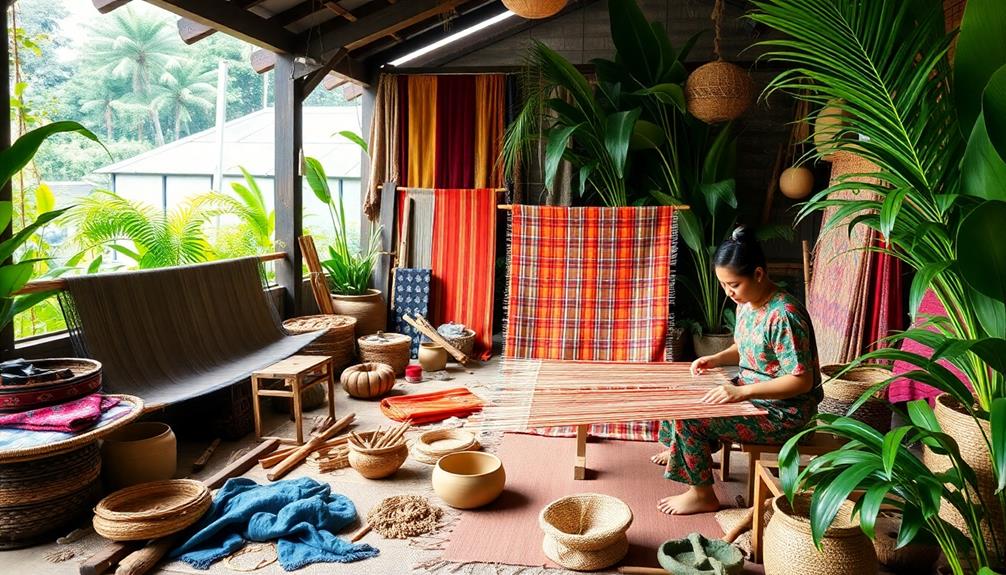
When you support local artisans in Indonesia, you're not just buying beautiful textiles; you're empowering women and preserving their rich cultural heritage.
These skilled artisans use traditional techniques passed down through generations, maintaining the identity of their communities while contributing to the unique aesthetic of tropical home decor.
Empowering Women Artisans
Empowerment thrives in the vibrant world of Indonesian textiles, where women artisans play an essential role in preserving traditional craftsmanship. By supporting these skilled artisans, you're not just acquiring beautiful textiles; you're also contributing to their livelihoods and cultural heritage.
Here's how empowering these women makes a difference:
- Promoting traditional skills that have been passed down through generations.
- Utilizing natural dyes to guarantee sustainable practices in textile production.
- Enhancing community relationships through the cultural significance of textiles in local exchanges.
- Documenting intricate processes, like the 56 steps in the red dye process, to preserve knowledge for future generations.
- Providing immersive learning opportunities for young women to gain hands-on experience in textile-making.
Your choice to invest in these textiles directly supports a community of artisans dedicated to maintaining their culture and skills.
It's a beautiful way to honor their heritage while bringing effortless elegance to your home. By embracing their craftsmanship, you're not just decorating your space; you're uplifting women artisans and guaranteeing their stories and skills continue to thrive.
Preserving Cultural Heritage
Supporting local artisans in Indonesia is crucial for preserving cultural heritage and the intricate techniques that define it. By investing in traditional textiles like batik, ikat, and songket, you help maintain the rich tapestry of Indonesia's artistic legacy. These textiles showcase intricate craftsmanship that reflects regional identities and historical contexts, making each piece unique.
Organizations such as Threads of Life work with over 1,000 weavers across 12 islands, ensuring that traditional techniques thrive. Their commitment to using natural dyes not only enhances the beauty of the fabrics but also supports sustainable practices.
You'll be pleased to know that the documentation of traditional dye processes, including the meticulous 56 steps to create red dye, guarantees that these skills are passed on to future generations.
Moreover, community engagement in textile production fosters local economies and emphasizes the importance of textiles in cultural ceremonies, such as bridewealth exchanges. By supporting these artisans, you're not just purchasing a beautiful piece for your home; you're also playing a crucial role in preserving Indonesia's cultural heritage for years to come.
Timeless Elegance in Home Design

Incorporating Indonesian textiles into your home design not only infuses spaces with vibrant colors and intricate patterns but also elevates your decor to a level of timeless elegance. Creating a unique and inviting atmosphere in your home can be achieved by integrating Indonesian textiles into your design. Whether you incorporate handmade batik fabrics into throw pillows or use designer showroom textiles for window treatments, the rich cultural heritage of Indonesian textiles can add a touch of luxury to any room. The combination of traditional craftsmanship and modern design sensibilities make Indonesian textiles a versatile and sophisticated choice for home decor.
These textiles, like batik and ikat, bring a unique character and warmth that transform any room. By blending traditional textiles with modern interior design, you can celebrate cultural heritage while creating a sophisticated atmosphere.
Consider these ways to enhance your home:
- Use luxurious songket fabric for accent pieces, adding a touch of sophistication.
- Incorporate handcrafted elements through cushions and wall hangings made from tenun and ulos.
- Mix vibrant Indonesian textiles with minimalist decor for an eye-catching contrast.
- Showcase intricate patterns on statement furnishings, creating unique decor that tells a story.
- Embrace the rich craftsmanship of Indonesia to foster a warm, inviting character in your spaces.
With these elements, you'll achieve an effortless elegance that honors tradition while fitting seamlessly into contemporary design.
Each piece tells a story, inviting admiration and appreciation for the artistry of Indonesian textiles in your home.
Frequently Asked Questions
What Is the Indonesian Textile Technique?
Indonesian textile techniques include batik, ikat, songket, tenun, and ulos. Each employs unique methods like dyeing and weaving, reflecting cultural heritage. You'll discover vibrant patterns and textures that tell stories of Indonesia's rich traditions.
What Are the Traditional Indonesian Textiles?
You might think all textiles are the same, but Indonesia offers unique ones like Batik, Ikat, Songket, Tenun, and Ulos. Each tells a story, showcasing rich cultural heritage and artistry that's truly enchanting.
Why Are so Many Clothes Made in Indonesia?
So many clothes are made in Indonesia because of its skilled workforce, competitive production costs, and high-quality natural fibers. These factors create vibrant, durable garments that appeal to both local and international markets.
What Is the Famous Fabric Design of Indonesia?
You might think all fabric's the same, but Indonesia's batik, ikat, and songket each tell a story. These unique designs reflect culture and history, transforming mere cloth into stunning expressions of artistry and heritage.
Conclusion
Incorporating Indonesian textiles into your home is like weaving a tapestry of stories and cultures that envelop you in warmth and elegance. Imagine wrapping yourself in a beautifully crafted batik blanket on a chilly evening; it's not just fabric, but a connection to artisans who pour their heart into every stitch. By embracing these textiles, you're not only enhancing your decor but also supporting a rich heritage, making your home a sanctuary of timeless beauty and meaningful craftsmanship.
